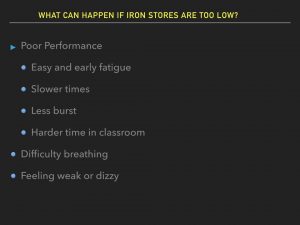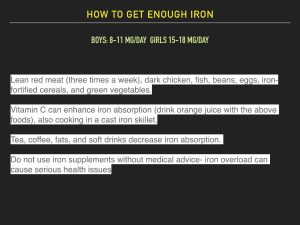Could low iron levels explain why you are struggling to finish hard workouts?
Is there a ferritin level that will make your run faster?
Unsure about how to answer these questions?
Not even certain what the term ferritin means?
No worries- click on the above video and read on to learn more.
Iron and Ferritin: What are they and can low levels doom performance?
Iron is an essential mineral that does many important things during exercise.
- It helps red cells carry oxygen from the lungs to working muscles
- Measures of red cell numbers include the hematocrit and hemoglobin values
- It helps muscles work more effectively and can also help the body get rid of waste products
Ferritin is a protein that stores iron in tissues.
Now, while many look at ferritin as “the be all and end all”, do realize it is not a perfect measure.
Ferritin is what we call an “acute phase reactant” which means it can go up and down quickly due to illness or inflammation in the body.
So, it may be falsely high or low depending on how the athlete felt on the day of the blood draw.
That’s why getting a full history, checking other lab values, and using good judgement are key.
For years, no one has doubted that exercise can suffer with both low red cell counts (called anemia) and low ferritin.
The controversy has been more around normal (or low normal) red cell counts with low ferritin.
Based on recent medical studies, the pendulum in coaching and sports medicine circles has shifted towards linking low ferritin with lower performance.
Please realize that there many other possible causes of these symptoms. Schedule a visit with your sports medicine professional if you have concerns with any of these issues.
RELATED CONTENT: CLICK HERE FOR IMPORTANT INFORMATION ON SLEEP AND OTHER RECOVERY TIPS
Iron and Ferritin: Which athletes are at higher risk for problems and who should be tested?
Medical experts may often order blood tests such as:
- Complete Blood Counts (includes hematocrit and hemoglobin)
- Total Iron and Iron Binding Capacity
- Ferritin
- Other measures such as Soluble Transferrin Receptor
Any athlete with concerns over exercise performance or above symptoms should consider having testing done.
Since it takes about 100 days for extra iron to change lab values and performance, some teams check during early pre-season training.
Iron and Ferritin: What is the magic ferritin level and can diet alone get me there ?
Reviewing both medical studies and from personal experience, a ferritin level of 20 is an initial cut-off.
Below 20, there is a higher risk of lower performance,
Get above 20, performance can tend to improve
Levels far above 20, such as 50-70 or even higher are even more ideal.
In especially high-level performers in the middle of seasons, it can be difficult to get and stay in the 20’s.
So, if checking ferritin levels I’ll prefer to see those 50-70+ results but will at minimum be happy with 20+.
Too much iron and too high of ferritin levels can also be dangerous to overall health.
Yes, leafy green vegetables have iron, but someone would have to eat a lot of spinach (like with every meal) to get their daily needs.
In my experience, supplemental iron may be recommended for athletes whose diets do not provide enough iron or who have proven low red cell or ferritin levels.
Since there are both possible short-term (constipation, stomach ache, stained teeth) and longer-term (organ damage) problems, do not take any high levels of supplemental iron without appropriate medical supervision.






